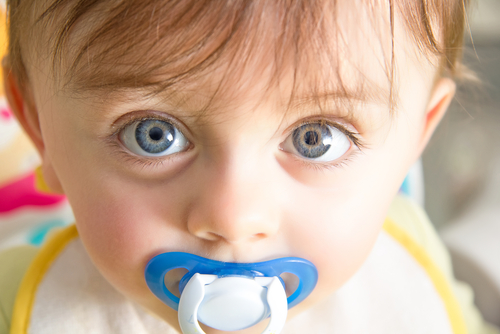Your girl here has a love/hate relationship with pacifiers. They are a great solution to soothing a fussy baby, especially when they are first born! Plus, it is one method to reduce the risk of SIDS. However, they can be your worst enemy if they become the prop or crutch that your baby needs to fall asleep.
I’m going to be honest with you, my daughter used a pacifier until she was almost 9 months old and that was WAY. TOO. LONG. Here’s why; at around 3 months she started sleeping through the night (it could have happened a lot earlier for us, but we were completely naive and didn’t know a damn thing about a baby’s sleep needs until then!), but we were giving her a pacifier every night to go to sleep. If she kept it in her mouth for long enough, then she’d fall asleep and stay asleep. BUT if it fell out too soon, or if she woke overnight and didn’t have her pacifier in her mouth, she would cry until my husband or I went into her room and put it back in. Then she’d either fall asleep, or it would fall out and the cycle would start all over again. While, at the time, this seemed like an ok trade off for getting her to sleep, it was just making things even harder down the road.
Okay, so WHEN do I drop the pacifier:
When a baby’s sleep changes from stages to cycles (around 12 weeks), they are waking up more often. This is why a lot of the time parents will see that dreaded 4 month sleep regression, because if your baby does not know HOW to fall asleep independently without any crutches, or aids, or assistance, then it’s going to be harder to teach them how to fall asleep without one. With that being said, if you are becoming the mechanism that has to put your baby’s pacifier back in their mouth every time it falls out, then it is time to drop it!
Now, there are some ways to avoid becoming that mechanism, but still allowing your child to have a pacifier. I know parents who will put a couple different pacifiers in the crib with their baby, so that if they lose one, they can find another fairly easily. However, your baby will need to know HOW to put the pacifier back into their own mouth if this method is going to work, so they’ll need their hands free which likely won’t work for a baby under the age of 4 months. This can be something you can practice with them during tummy time where you put the pacifier in front of them and have them grab it and put it into their mouth.
When it comes to toddlers, the tell tale sign is usually that the pacifier is constantly in their mouth. Pay attention to when they’re using it as well as how they’re using it. Are they suckling to be calm, or are they just sucking on it and playing with it just because? If so, it’s likely time to drop it. It can also cause dental and muscle development issues down the road. The American Academy of Pediatric Dentistry (AAPD) recommends weaning your child off of a pacifier before the age of 2 in order to avoid future dental complications like crowded teeth, underbites, overbites, crossbites, etc. It can also affect the tongue muscles and not allow them to move, develop, or function properly. Down the road, this can affect their speech as well as eating habits. Plus, trying to wean a cognitive toddler off of a pacifier is going to prove to be a lot harder than weaning an infant.
Okay, so HOW do I drop the pacifier?
I’ll start with infants first. Again, if you are finding that your baby cannot fall asleep without their pacifier, or if you or your partner are the one that is getting up fifteen times a night to put it back into their mouth; the pacifier is the prop, you are the mechanism, and it is time to drop it. It will take a baby ONE NIGHT; I’ll say it again, ONE NIGHT to discover that they can use their hands to suck on instead of a pacifier. If your baby is swaddled with their arms down, try swaddling them with their hands perched up on their chest so they can access them. You can also try a swaddle that allows for their arms to be up and their hands accessible, but still constricted enough where they are not woken up by their startle reflex. (Check out my last blog on what swaddle might be best for your baby HERE!)
Toddlers are a bit more complex, but here are some quick tips to start that weaning process
- The Take Away – It’s exactly what it sounds like. Just take it away, and brace yourself for the tantrums. You can offer something in it’s place like a lovie, blankie, or stuffed animal to help make the transition a bit easier. I’ve had some parents use the “Paci Fairy” method, where the fairy comes to take their paci, but leaves a lovie in it’s place. In a day or two, the tantrums will be behind you, and you’ll be paci free! Quick Tip: If your toddler takes well to the lovie, I recommend getting two or three of the same one so that you have a few in the rotation during laundry day, or if one were to get ruined or lost!
- Cut It Out – This is when you cut the tip of the pacifier just a TIIIINY bit, so that it’s barely seen by the eye, but will not give your child the same soothing sensation when they are sucking on it. Overtime, they’ll find that it’s not doing what it used to, and may simply just abandon it! Note: This might not be best for a toddler who is over the age of 2 as they are a bit more cognitive, and may notice that there is something wrong with their paci and want a new one to replace it.
- Limit to Bedtime – This is when you only allow your toddler to use their pacifier when it’s time for sleep (nap or bedtime). This can start the slower process of weaning them over time.
Moral of the story? Pacifiers can be complicated. Some people have children who take them when they’re infants, and then never need them again! Some have children that won’t even take a pacifier and wish they would! Like I said, it is easy to have a love/hate relationship with these damn things. Anyway, I hope this was helpful. And remember, you’re doing your best, you got this, and this too shall pass! Stay strong ?

